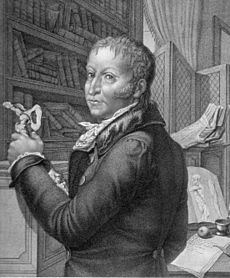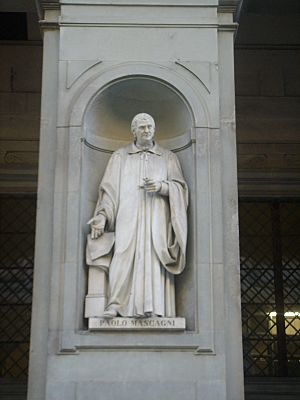Paolo Mascagni facts for kids
Quick facts for kids
Paolo Mascagni
|
|
|---|---|

Paolo Mascagni
|
|
| Born | 25 January 1755 Pomarance, Italy
|
| Died | 19 October 1815 (aged 60) Chiusdino, Italy
|
| Occupation | Anatomist |
| Parent(s) | Aurelio Mascagni & Elizabeth Burroni |

Paolo Mascagni (born January 25, 1755 – died October 19, 1815) was an Italian physician and anatomist. An anatomist is a scientist who studies the structure of living things. Mascagni is famous for being the first to fully describe the lymphatic system. This system is a network of vessels and organs that helps your body fight infections and keep fluids balanced.
Contents
Paolo Mascagni's Life Story
Early Years and Education
Paolo Mascagni was born in a town called Pomarance in Italy. His parents were Aurelio Mascagni and Elisabetta Burroni. They came from well-known families in a nearby area called Chiusdino.
Paolo went to the University of Siena. There, he studied philosophy and medicine. After he graduated in 1777, a famous anatomist named Pietro Tabarrani chose Mascagni to be his assistant. When Tabarrani passed away in 1780, Mascagni took over his role. He became an anatomy lecturer at the University of Siena.
Mascagni's Amazing Career
When he was young, Mascagni was interested in geology, which is the study of Earth's physical structure. He wrote several papers about the Lagoni of Siena and Volterra. These "Lagoni" are natural hot springs that release steam and gases from the ground.
After graduating, Mascagni focused on the human lymphatic system. He made many important discoveries in this area. These discoveries led him to write and publish a major book in 1787. The book was called Vasorum lymphaticorum corporis humani historia et iconographia.
His work was recognized by many. In 1796, he became a member of the Royal Swedish Academy of Sciences. In 1798, he was chosen to be the president of the Accademia dei Fisiocritici, a scientific academy.
During a time when French forces were in Tuscany in 1799, Mascagni supported their ideas. Because of this, he was put in prison for seven months after the French left. However, he was later set free by the King of Etruria. On October 22, 1801, the King appointed Mascagni as a professor of anatomy at the University of Pisa. He also had to teach at a hospital in Florence twice a week.
In 1807, Mascagni became a professor of anatomy at the University of Florence. While there, he wrote another important book called Treatise of Anatomy.
Working with Other Scientists
In 1781, Mascagni started working with a sculptor named Clemente Susini. Susini was creating a collection of human anatomical waxes. These were incredibly detailed wax models of the human body. The collection was finished in 1786 and included about 800 pieces.
Later, in 1801, an anatomist from Sardinia named Francesco Antonio Boi became Mascagni's student. Mascagni and Boi worked very closely together and became good friends. Some of their anatomical wax models are now kept in the National Archaeological Museum in Cagliari.
Mascagni's Passing
Paolo Mascagni died in 1815 from a serious infection called sepsis. Many years after his death, a statue was built in his honor. You can find it in the courtyard of the Uffizi gallery in Florence.
Mascagni's Lasting Impact
After Mascagni died, two more of his works were published:
- Prodromo della grande anatomia (1821)
- Anatomicae universae iconae (1823)
Mascagni is also now recognized for something he discovered a long time ago. He was the first to find tiny vessels in the brain called meningeal lymphatic vessels. However, his findings were not believed during his lifetime. These vessels were finally proven to exist in mice in 2014. Later, in 2017, scientists confirmed they also exist in humans and other primates. This shows how ahead of his time Mascagni was!
See also
 In Spanish: Paolo Mascagni para niños
In Spanish: Paolo Mascagni para niños


